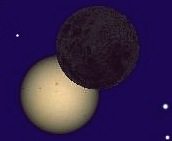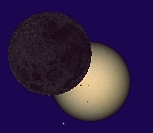
- - text and links as of last publication - -

Most of Australia, New Zealand, southern Argentina and Chile will be the only inhabited parts of the world to be able to watch as partial this total solar eclipse which is taking place in Antarctic regions. It is one month ahead summer in the southern hemisphere and midnight sun in Antarctica
As seen from where the Sun is coming, i.e. on the Pacific ocean side of the Earth, as it is near summer solstice in the southern hemisphere and that South Pole is tilted towards the Sun, the Moon' shadow is hiting Earth on the "other side" of the pole, i.e. on the side of Antarctica which is edged by the Indian ocean instead of reaching it on its side edged by the Pacific ocean. As a result of this peculiar geometry, the path of the eclipse is broad and arc-shaped
 | click to a view of the circumstances of the eclipse |
The eclipse is beginning at 22:19 UT southeast of Kerguelen Island and then turns and reaches Antarctica at 22:35 UT. Greatest eclipse occurs at 22:49:17 UT (maximum: 1 minute 55 seconds; solar altitude above the horizon: 15°). The eclipse then sweeps above the continent, then turns again and moves northwest, reaching Queen Maud Land. The eclipse eventually ends at 23:19 UT. The duration of the eclipse is so one hour
Eclipse is so reaching few populated areas and it's a great magic to think that the Moon's umbra is going to sweep over these desolate landscapes, illuminated by the midnight sun. Some Antarctic stations however will witness the event. Russian Antarctic station Mirnyy is most favoured as it lies just under the middle of the umbra's path. Novolazarevskaya (Russia) and Maitri (India) stations are too in the umbra's path and Asuka station lies at the border of it. The eclipse is partial for the greatest part of Australia (sunrise), for New Zealand (morning) and southermmost parts of Argentina and Chile (sunset). The thumbnail below leads to a global view of the circumstances of the eclipse (path of annularity, zones of partial visibility. The map is courtesy Fred Espenak, NASA/Goddard Space Flight Center. For more materials about this eclipse, see Fred Espenak's Eclipse Home Page)
For how an eclipse works and how to observe one, see the tutorials "Sun Eclipses" and "Observing a Sun Eclipse". Remember that observing an eclipse is as dangerous as usually observing the Sun. In the second tutorial, you will find advices about these dangers. Do not forget to see them!
Observation Reports: not a lot of reports have been published about the eclipse, especially for the places where it was partial. Here is how the eclipse was looking from Sydney, Australia in the morning of the 24th (left), or from southernmost South America just before sunset (right)
 |  | pictures with Cartes du Ciel, Patrick Chevalley |